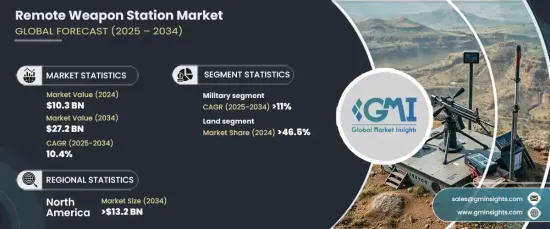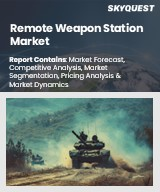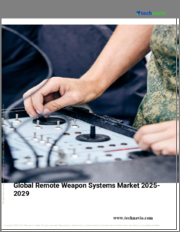
|
시장보고서
상품코드
1665314
원격 조종식 포탑(RWS) 시장 : 시장 기회, 성장 촉진요인, 산업 동향 분석, 예측(2025-2034년)Remote Weapon Station Market Opportunity, Growth Drivers, Industry Trend Analysis, and Forecast 2025 - 2034 |
||||||
세계의 원격 조종식 포탑 시장은 2024년에는 103억 달러에 달한 것으로 평가되었고, 2025년부터 2034년까지 CAGR은 10.4%로 견조하게 추이할 전망입니다. 이 성장의 원동력이 되고 있는 것은 선진적 방위 기술에 대한 수요 증가와, 군사력 강화에 대한 관심의 고조입니다. 지정학적 긴장 증가와 현대화된 전투 솔루션에 대한 지속적인 요구는 전 세계 방어 부문 전체에서 원격 무기 시스템의 보급에 박차를 가하고 있습니다.

시장은 육상, 해상, 공중의 세 가지 주요 플랫폼으로 분류됩니다. 육상 부문은 2024년에 46.5%로 큰 점유율을 차지했으며, 예측 기간 중에 큰 성장이 예상되고 있습니다. 군사 작전 확대와 차량 보호 향상에 대한 요구 증가가 이 부문 수요를 촉진하는 주요 요인입니다. 장갑차, 탱크, 수송 플랫폼에 탑재된 원격 조종식 포탑은 화력을 강화할 뿐만 아니라 승무원의 안전성도 향상시키고 있습니다. 원격조작에 의한 표적과의 교전이나 전장에서의 효율화가 중시되게 되어, 육상 시스템의 지속적인 성장을 더욱 뒷받침하고 있습니다.
| 시장 범위 | |
|---|---|
| 시작 연도 | 2024년 |
| 예측 연도 | 2025-2034년 |
| 시작 금액 | 103억 달러 |
| 예측 금액 | 272억 달러 |
| CAGR | 10.4% |
용도별로 시장은 군사 부문과 국토 안보 부문으로 나뉩니다. 군사 부문은 2034년까지 연평균 복합 성장률(CAGR) 11%의 고성장이 예상되고 있습니다. 전쟁 전략의 진화에 따라 작전 능력의 강화와 인원의 안전 확보를 목적으로 한 첨단 기술에 대한 투자가 확대되고 있습니다. 현대의 방위군은 적대적 위협에 대한 노출을 최소화하면서 전투 효과를 높이기 위해 원격 무기 시스템의 배치를 점점 더 진행하고 있습니다. 통합 시스템을 통해 원활한 연동과 실시간 상황 인식이 가능해지기 때문에 네트워크 중심 전쟁으로의 전환이 수요를 더욱 밀어 올리고 있습니다.
북미의 원격 조종식 포탑 시장은 2034년까지 132억 달러를 창출할 것으로 예상됩니다. 국방 예산 증가와 군사 인프라의 현대화의 진행과 같은 주요 요인이 이 지역의 성장을 가속하고 있습니다. 지상 차량, 함정, 무인 시스템의 업그레이드에 주력하고 있는 것이, 보다 높은 채용율을 지지하고 있습니다. 또한 인공지능, 머신러닝, 센서 기술의 발전으로 조준 정확도, 추적 및 사격 능력이 크게 향상되었습니다. 이러한 혁신은 운영 효율성을 높이고 이 지역의 방위 전략을 강화하고 있습니다.
목차
제1장 조사 방법 및 조사 범위
- 시장 범위 및 정의
- 기본 추정 및 계산
- 예측 계산
- 데이터 소스
- 1차 데이터
- 2차 데이터
- 유료 정보원
- 공적 정보원
제2장 주요 요약
제3장 산업 인사이트
- 생태계 분석
- 밸류체인에 영향을 주는 요인
- 이익률 분석
- 변혁
- 장래 전망
- 제조업체
- 유통업체
- 공급자의 상황
- 이익률 분석
- 주요 뉴스와 대처
- 규제 상황
- 영향 요인
- 성장 촉진요인
- 자율화 기술의 진보
- 군비의 근대화
- 멀티롤 RWS 시스템에 대한 수요 증가
- 안보 우려 및 지역적 긴장 증가
- 전투 시나리오에서 병사의 피폭을 최소화하는 방향으로 이동
- 산업의 잠재적 리스크 및 과제
- 기존 플랫폼과의 복잡한 통합
- 높은 초기 비용
- 성장 촉진요인
- 성장 가능성 분석
- Porter's Five Forces 분석
- PESTEL 분석
제4장 경쟁 구도
- 서문
- 기업 점유율 분석
- 경쟁 포지셔닝 매트릭스
- 전략 전망 매트릭스
제5장 시장 추정 및 예측 : 플랫폼별(2021-2034년)
- 주요 동향
- 육상
- 전투 차량
- 주력 탱크
- 보병 전투 차량
- 장갑 전투 차량
- 무인 지상 차량
- 기타
- 거치형 구조물
- 전투 차량
- 해상
- 구축함
- 프리게이트
- 코르벳
- 초계 및 수뢰 대책 함정
- 해외 순시선(OPVs)
- 수륙 양용 함정
- 무인 수상 차량
- 공중
- 전투기
- 공격 헬리콥터
- 무인 항공기
제6장 시장 추정 및 예측 : 무기 유형별(2021-2034년)
- 주요 동향
- 치사성 무기
- 소구경
- 5.56mm
- 7.62mm
- 12.7mm
- 중구경
- 20mm
- 25mm
- 30mm
- 40mm
- 소구경
- 비치사성 무기
제7장 시장 추정 및 예측 : 모빌리티별(2021-2034년)
- 주요 동향
- 고정
- 이동
제8장 시장 추정 및 예측 : 용도별(2021-2034년)
- 주요 동향
- 군사
- 국토 안보
제9장 시장 추정 및 예측 : 지역별(2021-2034년)
- 주요 동향
- 북미
- 미국
- 캐나다
- 유럽
- 영국
- 독일
- 프랑스
- 이탈리아
- 스페인
- 러시아
- 아시아태평양
- 중국
- 인도
- 일본
- 한국
- 호주
- 라틴아메리카
- 브라질
- 멕시코
- 중동 및 아프리카
- 남아프리카
- 사우디아라비아
- 아랍에미리트(UAE)
제10장 기업 프로파일
- Aselsan
- BAE Systems
- Bharat Electronics
- Copenhagen Sensor Technology
- Elbit Systems
- EVPU Defense
- FN Herstal
- General Dynamics
- Hornet
- Israel Aerospace Industries
- Kongsberg Gruppen
- Leonardo
- Northrop Grumman
- Rafael Advanced Defense Systems
- Raytheon Technologies
- Rheinmetall
- Saab
- Singapore Technologies Engineering
- Thales
The Global Remote Weapon Station Market is projected to reach USD 10.3 billion in 2024 and is expected to experience a robust CAGR of 10.4% from 2025 to 2034. This growth is driven by an increasing demand for advanced defense technologies and a heightened focus on enhancing military capabilities. Rising geopolitical tensions and the continuous need for modernized combat solutions are fueling the widespread adoption of remote weapon systems across defense sectors globally.

The market is categorized into three main platforms: land, naval, and airborne. The land-based segment holds a substantial share of 46.5% in 2024 and is anticipated to see significant growth over the forecast period. Expanding military operations and the rising need for improved vehicle protection are key factors driving the demand in this segment. Remote weapon stations mounted on armored vehicles, tanks, and transport platforms not only enhance firepower but also improve crew safety. The growing emphasis on remote target engagement and greater battlefield efficiency further supports the sustained growth of land-based systems.
| Market Scope | |
|---|---|
| Start Year | 2024 |
| Forecast Year | 2025-2034 |
| Start Value | $10.3 Billion |
| Forecast Value | $27.2 Billion |
| CAGR | 10.4% |
In terms of application, the market is divided into military and homeland security sectors. The military sector is expected to grow at a strong CAGR of 11% through 2034. As warfare strategies evolve, there is a growing investment in advanced technologies designed to enhance operational capabilities and safeguard personnel. Modern defense forces are increasingly deploying remote weapon systems to boost combat effectiveness while minimizing exposure to hostile threats. The shift toward network-centric warfare further drives demand, as it enables seamless coordination and real-time situational awareness through integrated systems.
The North American remote weapon station market is projected to generate USD 13.2 billion by 2034. Key factors such as rising defense budgets and ongoing modernization of military infrastructure are driving this region's growth. The focus on upgrading ground vehicles, naval vessels, and unmanned systems supports a higher rate of adoption. Additionally, advancements in artificial intelligence, machine learning, and sensor technologies are significantly improving targeting accuracy, tracking, and firing capabilities. These technological innovations are enhancing operational efficiency and strengthening defense strategies in the region.
Table of Contents
Chapter 1 Methodology & Scope
- 1.1 Market scope & definitions
- 1.2 Base estimates & calculations
- 1.3 Forecast calculations
- 1.4 Data sources
- 1.4.1 Primary
- 1.4.2 Secondary
- 1.4.2.1 Paid sources
- 1.4.2.2 Public sources
Chapter 2 Executive Summary
- 2.1 Industry synopsis, 2021-2034
Chapter 3 Industry Insights
- 3.1 Industry ecosystem analysis
- 3.1.1 Factor affecting the value chain
- 3.1.2 Profit margin analysis
- 3.1.3 Disruptions
- 3.1.4 Future outlook
- 3.1.5 Manufacturers
- 3.1.6 Distributors
- 3.2 Supplier landscape
- 3.3 Profit margin analysis
- 3.4 Key news & initiatives
- 3.5 Regulatory landscape
- 3.6 Impact forces
- 3.6.1 Growth drivers
- 3.6.1.1 Advancements in autonomous technology
- 3.6.1.2 Modernization of military forces
- 3.6.1.3 Rising demand for multi-role RWS systems
- 3.6.1.4 Increasing security concerns and regional tensions
- 3.6.1.5 Shift towards minimizing soldier exposure in combat scenarios
- 3.6.2 Industry pitfalls & challenges
- 3.6.2.1 Complex integration with existing platforms
- 3.6.2.2 High initial costs
- 3.6.1 Growth drivers
- 3.7 Growth potential analysis
- 3.8 Porter’s analysis
- 3.9 PESTEL analysis
Chapter 4 Competitive Landscape, 2024
- 4.1 Introduction
- 4.2 Company market share analysis
- 4.3 Competitive positioning matrix
- 4.4 Strategic outlook matrix
Chapter 5 Market Estimates & Forecast, By Platform, 2021-2034 (USD Million & Units)
- 5.1 Key trends
- 5.2 Land
- 5.2.1 Combat vehicles
- 5.2.1.1 Main battle tanks
- 5.2.1.2 Infantry fighting vehicles
- 5.2.1.3 Armored fighting vehicles
- 5.2.1.4 Unmanned ground vehicles
- 5.2.1.5 Others
- 5.2.2 Stationary Structures
- 5.2.1 Combat vehicles
- 5.3 Naval
- 5.3.1 Destroyers
- 5.3.2 Frigates
- 5.3.3 Corvettes
- 5.3.4 Patrol & mine countermeasures vessels
- 5.3.5 Offshore patrol vessels (OPVs)
- 5.3.6 Amphibious vessels
- 5.3.7 Unmanned surface vehicles
- 5.4 Airborne
- 5.4.1 Fighter aircraft
- 5.4.2 Attack helicopters
- 5.4.3 Unmanned aerial vehicles
Chapter 6 Market Estimates & Forecast, By Weapon Type, 2021-2034 (USD Million & Units)
- 6.1 Key trends
- 6.2 Lethal Weapons
- 6.2.1 Small Caliber
- 6.2.1.1 5.56mm
- 6.2.1.2 7.62mm
- 6.2.1.3 12.7mm
- 6.2.2 Medium Caliber
- 6.2.2.1 20mm
- 6.2.2.2 25mm
- 6.2.2.3 30mm
- 6.2.2.4 40mm
- 6.2.1 Small Caliber
- 6.3 Non-lethal Weapons
Chapter 7 Market Estimates & Forecast, By Mobility, 2021-2034 (USD Million & Units)
- 7.1 Key trends
- 7.2 Fixed
- 7.3 Moving
Chapter 8 Market Estimates & Forecast, By Application, 2021-2034 (USD Million & Units)
- 8.1 Key trends
- 8.2 Military
- 8.3 Homeland security
Chapter 9 Market Estimates & Forecast, By Region, 2021-2034 (USD Million & Units)
- 9.1 Key trends
- 9.2 North America
- 9.2.1 U.S.
- 9.2.2 Canada
- 9.3 Europe
- 9.3.1 UK
- 9.3.2 Germany
- 9.3.3 France
- 9.3.4 Italy
- 9.3.5 Spain
- 9.3.6 Russia
- 9.4 Asia Pacific
- 9.4.1 China
- 9.4.2 India
- 9.4.3 Japan
- 9.4.4 South Korea
- 9.4.5 Australia
- 9.5 Latin America
- 9.5.1 Brazil
- 9.5.2 Mexico
- 9.6 MEA
- 9.6.1 South Africa
- 9.6.2 Saudi Arabia
- 9.6.3 UAE
Chapter 10 Company Profiles
- 10.1 Aselsan
- 10.2 BAE Systems
- 10.3 Bharat Electronics
- 10.4 Copenhagen Sensor Technology
- 10.5 Elbit Systems
- 10.6 EVPU Defense
- 10.7 FN Herstal
- 10.8 General Dynamics
- 10.9 Hornet
- 10.10 Israel Aerospace Industries
- 10.11 Kongsberg Gruppen
- 10.12 Leonardo
- 10.13 Northrop Grumman
- 10.14 Rafael Advanced Defense Systems
- 10.15 Raytheon Technologies
- 10.16 Rheinmetall
- 10.17 Saab
- 10.18 Singapore Technologies Engineering
- 10.19 Thales



















